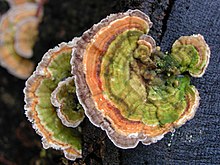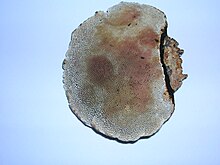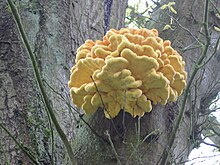
Back Porling German Polypore Spanish قارچهای تاقچهای Persian Käävät Finnish Polypore French Աբեթասնկեր Armenian Poliporo IO 多孔菌 Japanese აბედა სოკოები Georgian Сем панго MYV
This article needs additional citations for verification. (November 2009) |

Polypores are a group of fungi that form large fruiting bodies with pores or tubes on the underside (see Delimitation for exceptions). They are a morphological group of basidiomycetes-like gilled mushrooms and hydnoid fungi, and not all polypores are closely related to each other. Polypores are also called bracket fungi or shelf fungi, and they characteristically produce woody, shelf- or bracket-shaped or occasionally circular fruiting bodies that are called conks.[1]
Most polypores inhabit tree trunks or branches consuming the wood, but some soil-inhabiting species form mycorrhiza with trees. Polypores and the related corticioid fungi are the most important agents of wood decay, playing a very significant role in nutrient cycling and aiding carbon dioxide absorption by forest ecosystems.[2]
Over one thousand polypore species have been described to science,[3] but a large part of the diversity is still unknown even in relatively well-studied temperate areas. Polypores are much more diverse in old natural forests with abundant dead wood than in younger managed forests or plantations. Consequently, a number of species have declined drastically and are under threat of extinction due to logging and deforestation.
Polypores are used in traditional medicine, and they are actively studied for their medicinal value and various industrial applications. Several polypore species are serious pathogens of plantation trees and are major causes of timber spoilage.




Conks, the fruiting bodies of polypores, lie in a close planar grouping of separate or interconnected horizontal rows. Brackets can range from only a single row of a few caps, to dozens of rows of caps that can weigh several hundred pounds. They are mainly found on trees (living and dead) and coarse woody debris, and may resemble mushrooms. Some form annual fruiting bodies while others are perennial and grow larger year after year. Bracket fungi are typically tough and sturdy and produce their spores, called basidiospores, within the pores that typically make up the undersurface.
- ^ Bessette, Alan E.; Smith, Dianna; Bessette, Arleen R. (2021-09-15). Polypores and Similar Fungi of Eastern and Central North America. University of Texas Press. ISBN 978-1-4773-2272-7.
- ^ Averill, Colin; Bhatnagar, Jennifer (15 August 2018). "Four Things to Know about Fungi "Climate Warriors" BU researchers explain how fungi fight climate change". The Brink - Research from Boston University. Boston University. Retrieved 1 November 2022.
- ^ Kirk PM et al. (2008) Ainsworth and Bisby's dictionary of the fungi. 10th edition. CABI Europe.
- ^ a b Phillips, Roger (2006), Mushrooms. Pub. McMilan, ISBN 0-330-44237-6. P. 314.
© MMXXIII Rich X Search. We shall prevail. All rights reserved. Rich X Search